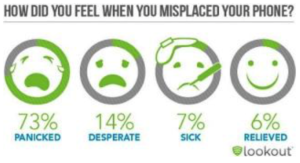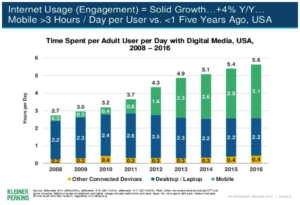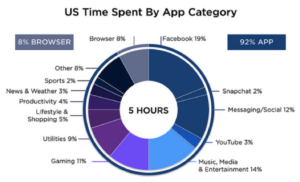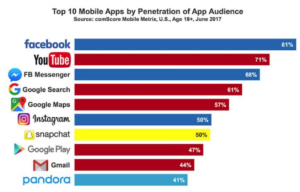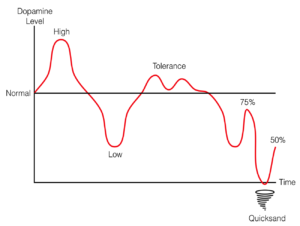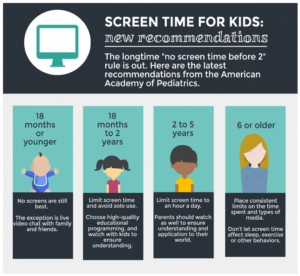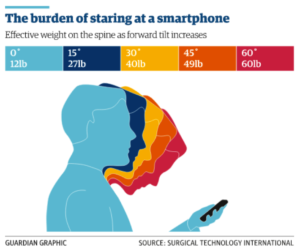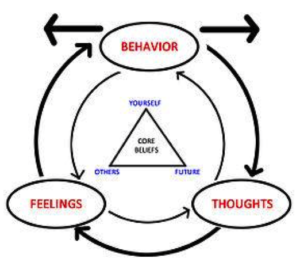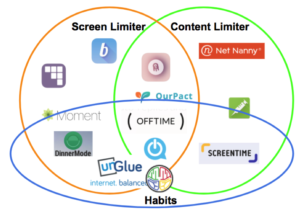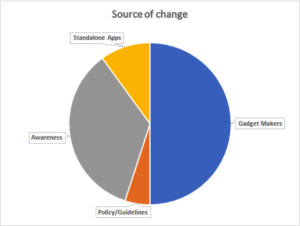Gadget Addiction
by Ananth Indrakanti, Milan Chutake, Stephen Prouty, Venkat Sundaranatha, Vinod Koverkathu
Introduction
Technology and gadgets are now indispensable in our daily lives. In the past few years carrying a miniature computer (a smart phone) in a pocket has become commonplace. Technology helps advance the human race forward and makes doing mundane things more efficient and repeatable. Technology has helped create the information revolution.
With technological advances, devices have evolved to be so powerful and smart that it feels like having a super-computer on one’s hands. Humans now have an insatiable appetite for information at their fingertips. When technology makes this happen, the natural tendency is for this to become an expectation. When was the last time you printed a map or wrote a snail mail letter? If you did, then you belong to the elite endangered cadre of humans who are vanishing rapidly. Welcome to the information age! Before we frame our problem, we would like to ponder briefly over how our lives have changed with gadgets, compared to pre-digital era.
Life Without Gadgets
People born before the 1980’s would very well relate to life before the information age, when people had no access to internet or personal gadgets. Let's briefly walk down the memory lane to relive those moments — a life without gadgets.
- Children played together outdoor — they had a lot of physical activity.
- People talked to each other more often, and verbal communication face-face was at its peak.
- Chat jargon did not exist and people knew their spellings well, as they read more books.
- People enjoyed spending more time outdoors with family and friends.
- It was commonplace to get the news from newspaper or radio.
- Entertainment came from playing board games, playing sports, going to the movies, watching VHS tapes, etc.
- Writers often used either a type-writer or a word processor on their computer.
- Computers were expensive and bulky.
- Doing research was hard; frequent visits to the library or scouring through plethora of papers, books, etc. were necessary.
- Communication was slow.
Life With Gadgets
Gadgets equipped with internet have transformed our lives in several ways and brought about a paradigm shift in our dependence on technology to perform key tasks in our everyday routine. To highlight a few:
- Enormous amount of information at our fingertips
- Use Google Maps to get directions, watch YouTube videos to learn to cook, sing, draw, learn science, etc.
- Health monitoring apps on the cell phone that would remind people to walk, run, bike, check BP periodically, etc.
- Capability to share daily life or special events instantly with thousands of people and see reaction in a matter of minutes, if not seconds
- Expedited research with access to information galore
- Ability to watch videos on demand from anywhere (Netflix, Amazon, etc.)
- Ability to read e-books online on demand — no more visits to library needed
- Use of mobile phones, tablets as pacifiers for kids
- Improved speed of communication by orders of magnitude leading to faster decision-making
- Existence of mobile apps for entertainment, social interaction through digital media, paying bills, accessing bank accounts, etc. (virtually for any purpose)
While there have been advantages to this information age and gadget revolution, it has created an insatiable appetite for information. It's now an expectation that information be readily available on demand from anywhere. This is the age of instant gratification. While technology has fostered the human race, does our current consumption pattern adversely impact our analytical and creative abilities, lead to loss of focus in communication and make us just indexers of data rather than bearers of knowledge? Are we addicted to our gadgets? Let's find out.
You’ve temporarily misplaced your cell phone and anxiously retrace your steps to try to find it. Or perhaps you never let go of your phone — it's always in your hand, your pocket, or your bag, ready to be answered or consulted at a moment’s notice.
Dr. Veronika Konok and her collaborators[1] cite evidence that supports the idea that “healthy, well-functioning adults also report significant emotional attachment to special objects.”
A quick survey showed that most people panicked when they had misplaced their smartphones (Fig. 1).
Figure 1: Survey results from “Lookout”
Mobile Consumption Growth Trend
In the last decade, digital consumption on mobile devices has overtaken that on desktop devices. Between 2011 and 2016, about 300% growth[2] (Fig. 2) was seen with data consumption on mobile devices, while that on desktop devices and other connected devices stayed relatively flat. The growth in combined number of smartphone/tablet users is expected to grow from current 2.5 billion to about 3.13 billion by 2020 (about 23%).
Social networking, listening to music, watching videos and playing games represent the bulk of what people do with their smartphones and tablets. Essentially it’s about communication and entertainment, two things that help people to cope with the level of stress in today’s world.
Figure 2: Time spent per adult user/day with digital media
Americans tend to spend more than 11 hours/day on a screen (mobile phone/desktop/tablet, etc.), be it for personal use or work-related activity. About half of the screen time is spent on a mobile device. Statistics[3] show that 8% of the time spent on a mobile is on a browser while the majority (92%) of the time is spent on social networking/media, music and entertainment apps. (Fig. 3)
Figure 3: Ratio of time spent on mobile by app category
Mobile App Usage Statistics
It will have been a decade since the establishment of the mobile app ecosystem by the summer of 2018. The total number of mobile app downloads touched 197 billion in 2017[3]. The two biggest app stores, i.e., Apple’s iOS App store and Google’s Play store, have served as effective app distribution channels for the millions of app developers in the ecosystem.
Not surprisingly, Facebook app demonstrated the highest level of penetration among 18+ years age group with a whopping 81% in 2017, while YouTube came second with 71% penetration and Facebook Messenger was not too far behind with 68% penetration. It is interesting to note that the chart is completely dominated by Facebook-owned (Facebook, FB messenger and Instagram) and Google-owned (Google search, Google Maps, Gmail, Google Play) apps, with Snapchat and Pandora being the only exceptions. It is also intriguing that social networking and entertainment are valued the most by app users worldwide.
Figure 4: Mobile apps penetration chart
The Invisible Problem
The business model of social networking and entertainment sites/apps like Facebook, Twitter, YouTube, Snapchat, etc. revolves around[4]:
- Sophisticated methods to seek attention of the maximum number of users and maximize the users’ time spent on these apps, i.e., make users interact and share their experiences, actions with the online community frequently and crave for virtual rewards (likes, comments)
- Enablement and empowerment of advertisers to target these users continually while scrolling through feeds in Facebook or browsing through videos on YouTube
- Learning from user interests (vacation preferences, activities etc.) and developing products that targets these users with AI driven personalized content, feeds and advertisements 24x7, where they start maneuvering the user behavior to their advantage.
While there is no denying that the business model is tuned to maximize users’ attention and time spent on these apps leading to gadget addiction and increased screen time, the other major problem that needs to be highlighted is that these platforms have no way to validate content being fed to users, i.e., fake news, articles generated to manipulate minds can be easily spread with these apps with no regulations or checks in place.
Let’s elaborate the point on how users that get initiated into these platforms develop the tendency to repeatedly visit them and ultimately get addicted, without any external force. How does this really work?
The Science of Addiction
Nir Eyal’s Hooked model explains the four stages we run through as we use the platform[5]:
- Boredom acts as an internal trigger, and external notifications add to that.
- The action is dead simple: open the app or page in the browser.
- A great variability of rewards is bestowed upon us: photos, comments, likes, gossip, news, emotions, laughter. The wheel of fortune never disappoints.
- We invest more and more time and attention into interacting on the platform, which keeps us coming back.
Taken together, these elements are what have caused so many of us to spiral into addiction. The worst part is we do it to ourselves.
Effects of Gadget Addiction
While the business model of the top few app companies hinges on people spending more time with their gadgets every day, we need to recognize that the most important fallout of this induced behavior would be the rising epidemic of gadget addiction. A sense of urge to use the phone or any other gadget when bored or idle equates to addiction. Gadget addiction doesn't discriminate who is affected, it affects all age groups and people of all races. The effects range from mental, physical, emotional to even threatening our democracy.
Mental and Emotional Health
Dopamine is a neurochemical that largely controls the pleasure and reward centers of the brain. High levels of dopamine are usually associated with motivation and excitement to fulfil goals that would lead to recognized rewards and thus reinforcement of a sense of pleasure while achieving those goals. Procrastination, lack of enthusiasm and self-confidence, and boredom are linked to low levels of dopamine.
Research has shown that the brain gets “rewired” as excessive amounts of dopamine get released in the body on frequent interaction with a rewarding stimulus, i.e., using a smartphone app like Facebook[6]. Boredom triggers an interaction with the rewarding stimulus (Facebook app), which in turn results in wide variety of rewards in the form of likes, messages, photos, etc. causing high releases of dopamine in the body. Frequent cycles such as these cause the brain’s receptors to become more insensitive to dopamine, causing the body to experience less pleasure than before for the same natural reward. This leads the person down a spiral, where one has increased craving for the same reward to achieve normal levels of pleasure. If the increased craving cannot be satisfied, it would lead to anxiety, lack of motivation and depression. Gadget addiction is likened to addiction to alcohol or drugs since it results in similar negative consequences.
Studies[7] have shown that children's cognitive and emotional development can be adversely impacted by internet/gadget addiction. More screen time means more virtual interactions and rewards through social media (shares, likes) and less face time. Less face-to-face interaction with other people results in lack of empathy for fellow human beings. As social media glorify picture-perfect lives and well-toned physiques, children’s self-esteem and self-confidence are eroded. Lack of focus and more distraction during conversations is another expected negative impact. A study on China high school students[8] demonstrated that children with moderate to severe risk of internet addiction are more than twice as likely to develop depressive symptoms than addiction-free counterparts.
Figure 5: Dopamine level releases w.r.t time
Physical Health
Today’s children are immersed in technology right from a very young age. With more than half the schools in the US using smart devices as teaching tools in class, coupled with at-home smart device usage, the total screen exposure time of students in the age group 8-18 has exceeded ten hours a day[9]. There are obvious benefits to being exposed to technology right from a very young age, i.e., development of skills needed to be successful in technology-related areas in a future career. However, on the downside, there could be lack of development of social behavioral skills and high risk of obesity due to limited physical activity.
As one would also expect, one of the biggest health risks of excessive smart device usage is vision-related. The National Eye Institute[10] has found that the frequency of myopia (near-sightedness) has increased exponentially in Americans over the last few decades. The other effect on eyes was reduced blink rate leading to higher incidence of dry eye symptoms. Based on these findings, the American Academy of Pediatrics[11] has revised recommendations for limiting screen time for kids at different ages.
Figure 6: Recommended screen time for kids (American Academy of Pediatrics)
Listening to loud music through earbuds has detrimental effects on hearing ability The National Institute of Deafness and Other Communication Disorders[13] as the head tilt increases to view the screen.
Figure 7: The burden of starting at a smartphone
Human Behavior
Figure 8: Cognitive-behavioral therapy[14]
Cognitive-behavioral therapy depicts how emotions, thoughts and behaviors influence each other. This model has been very useful in treatment of substance abuse, addictions, gambling addiction, smoking cessation etc.With advent of social networks, our emotional dependence is on instant likes, brief instant text messages creating a virtual set of friends who may never be physically present. Opinions and judgements are made without actual human connection and in-depth in person discussions. The virtual instant digitized friend circle gives a sense of belonging and feeling of having many friends who care about us. The HOOK business model leverages this human emotional dependence feeling and transforms those feelings into behavior where one feels like constantly engaging with these social networking platforms seeking for instant gratifications. When one does not get the instant emotional support in the forms of likes, instant messages then one starts feeling anxious, lonely and moody. Lot of the younger generation seem to start losing self-esteem and self-confidence if their friends fail to like their picture or respond to their posts instantly. In a nutshell the human behavior is being digitized.
Politics
Our political discourse is shrinking to fit to our smartphone screens. The most classic example is when President Obama used Instagram to push forward his climate change agenda.
The HOOK business model has got us addicted to our gadgets to watch the next post or news on social media. Well, this hunger for information can have both positive and negative impacts on our society and democracy. Social media may not create our bad habits, but it feeds them, and for one reason alone: money. In 1920’s it was the radio that reduced people to their voices, then in 1960’s television gave people their bodies back. Today with public looking to smartphones for news and media we seem to be in the third wave of election engineering. A recent survey found that 37% of people trust the news that get from social media — that's half the share from print and magazine media.
Let's consider the positive impacts. Few years ago, touch was used to connect with people especially if you're not the outgoing type. These platforms allow us to tailor the message to the audience, do fundraising, and get feedback. The momentum for the movements to topple regimes in Libya and Tunisia[15] was powered by these platforms. The more visceral the message, the more quickly it goes viral and the longer it holds the darting public eye. Around the world, these platforms like social media are making it easier for people to have a voice in the government, to discuss issues, organize around causes, and hold leaders accountable.
The argument is not complete without the negative impacts. For example, bots are often used to amplify political messages. The financial crisis of 2007-2008 stoked public anger[16] when the wealthy left everyone behind. These culture wars have split voters by their identity rather than class. It is claimed that more than 146 million people could have potentially seen fake news in their feed during the 2016 election year. These companies have moral responsibility to let users know that content might not be real.[17]
Don’t ask about the intentions, aspirations or responsibilities of social media companies. Just follow the money, that’s the basis of the HOOK business model.
How is society responding?
As we see the rise of ill effects of long term gadget use, rising health concerns amidst this drive to seek mindshare, finite attention of the same consumers there are groups of individuals who are now speaking up and taking a stand. These groups are investors, ex-employees of these companies and consumer groups. Starting 2018 these voices have amplified and there is a call for action and change is imminent.
Apple Investor's Open Letter
A pair of investors who hold about $2 billion in Apple stock are pushing the company to do more to protect its youngest users from the effects of digital technology[18]. In an open letter to Apple, the investors, the activist hedge fund Jana Partners and the California State Teachers’ Retirement System, voiced concerns that such technology might be hurting children and said Apple could help ease the damage even as it generates business.
Addressing the issue now could help Apple avoid an impending reckoning as unease grows over the role technology and social media play in our daily lives, the shareholders wrote. “There is a developing consensus around the world including Silicon Valley that the potential long-term consequences of new technologies need to be factored in at the outset, and no company can outsource that responsibility,” the investors wrote. The solution, they argued, is not to banish such devices from children’s hands, but to help parents help them understand how to use technology with care. The open letter highlights growing concern that Silicon Valley is damaging youth and urges new parental controls, child protection committee and release of data.
The Center for Humane Technology
A group of Silicon Valley technologists who were early employees at Facebook and Google[19], concerned over the ill effects of social networks and smartphones, are getting together to challenge the very companies they helped build. They have come together to a union of concerned experts called the Center for Humane Technology[20]. It plans an anti-tech addiction lobbying effort and an ad campaign at 55,000 public schools in the United States. The campaign, titled The Truth About Tech, will be funded with $7 million from Common Sense and capital raised by the Center for Humane Technology.
One of the co-founders of Center for Humane Technology — Harris, a former design ethicist at Google — mentions[21] it is not enough to simply turn your phone to gray or to stop using these tools entirely. Always-on technology is now baked into the social fabric. The teen who quits Snapchat risks missing out on the primary way his peers communicate. The employee who declines to answer her boss's after-hours email risks losing career opportunities. Which is why Harris is calling on the companies themselves to redesign their products with ethics, not purely profits, in mind, and calling on Congress to write basic consumer protections into law.
How is the industry responding?
With the clamour for change, companies who have a larger part to play in this ecosystem have realised that they need to acknowledge and recognize that there is an issue and at least have controls in place to alleviate the impact and negative PR around these issues.
Based on our understanding of this ecosystem and bucketing the responses we expect the changes to come from the following groups:
- Device Makers
- App Makers
- Popular Apps
- Standalone Apps
- Regulations
- Self-awareness
Device Makers
Device makers have a very large influence on this ecosystem. Availability of platform level features could make a big difference to the user experience, privacy and parental controls across apps and device interaction itself. Ever since these issues have got increased media attention has forced device makers to think of alternatives or at least options in place for concerned groups. Some of the options available natively on device are the following:
- Grayscale option
- Parental controls - purchases, time limitations, app usage limitations
- Night light - predominant on reading devices and reading apps
Shades of Gray
Tristan Harris from Center for Humane Tech proposed[22] using shades of gray is to make the glittering screen a little less stimulating. Based on a popular report, “We’re simple animals, excited by bright colors, it turns out.” Silicon Valley companies know this, and they have increasingly been turning to the field of applied neuroscience to see how exactly brains respond to color in the apps, what brings pleasure and what keeps the eye. New research shows how important color is to our understanding of priorities and emotion. Grayscale can make the display more readable for those who are color blind. Second, if your battery is running low and you know that it will be a while before you'll have the opportunity to charge it, grayscale can extend battery life. Third, some experts say that using grayscale on your iPhone might be the answer to the question of how to break phone addiction. Not so popular but turns out iOS and Android devices have controls to switch to grayscale mode. On the iPhone grayscale mode can be turned on from Accessibility controls. On Android it’s a slightly more difficult workflow to enable grayscale. First up, you'll need to enable the hidden "Developer Options" menu. Under the Hardware accelerated rendering section, choose "Monochromacy" on the popup, then your screen will immediately enter grayscale mode.
Apple: In January 2018, Apple said it would introduce new features to help parents control their children’s use of the company’s products[23]. The move came after two Apple shareholders posted an open letter pushing Apple to address what is seen as a “growing public health crisis” of smartphone addiction in young people. Now, Apple has a new page on its site that collects information about the company’s family features and parental controls in one place[24].
The page showcases features including an Ask To Buy tool that lets parents approve or decline app purchases from their device; an app management feature that lets users automatically block in-app purchases automatically; and the option to limit adult content on kids’ devices and restrict browsing to only pre-approved websites. Apple’s Find My Friends can also help track locations and issue alerts when children leave or arrive somewhere.
Google: Google announced the launch of Family Link in March 2017[25], an application for parents that lets them establish a child’s first Google account, as well as utilize a series of parental controls to manage and track screen time, daily limits, device “bedtimes,” and which apps kids can use.
While all the major mobile device providers – Apple, Google, and Amazon included – offer parental controls on their devices, Family Link is different because it’s a two-party system. Instead, it works more like the third-party parental control and monitoring software already on the market, where an app installed on a parent’s device is used to configure settings and keep an eye on kids’ digital behavior.
Parental Control devices: This is the other class of devices that can help you create a safe online environment for your kids over your home wireless network. The advantage is that any parental control settings you apply to a network will apply to all devices connected to the Wi-Fi. You don’t have to install software on each individual device, and you can filter content right at the source. The disadvantage, however, is that the parental control options are generally less flexible and only apply when the devices are used at home. Here are some of the popular parental control devices available in the market today:
Popular Apps
Some of the popular apps have also taken steps to attempt to solve the “device addiction” problems. Here are some of the notable initiatives.
Facebook: In January 2018 Mark Zuckerberg announced[30] a major overhaul of Facebook’s News Feed algorithm that would prioritize “meaningful social interactions” over “relevant content” on Thursday, one week after he pledged to spend 2018 “making sure that time spent on Facebook is time well spent”. The social media platform will de-prioritize videos, photos, and posts shared by businesses and media outlets, which Zuckerberg dubbed “public content,” in favor of content produced by a user’s friends and family[31].
Youtube: Google launched a service called YouTube Kids in February 2015[32], a new version of the internet’s leading destination for video aimed squarely at children. YouTube Kids limits the world of content on the service to curated, family-friendly videos, channels, and educational clips. It also includes features like timer settings to limit screen time and a search function. The search gives users access to YouTube’s main database of videos, but that YouTube Kids’ results are automatically filtered for safe content. The service also gives adults a range of parental controls, including the ability to disable search completely, limit screen time and cap the volume. Google has disabled comments on the service, but it does show some kid-friendly ads.
Standalone Apps
There are multiple independent, third party apps of varying quality. These are mostly from smaller startups with limited revenue. Some of these could be effective, but involves searching for the right app and downloading it on all devices. The illustration covers some of the apps in this space.
Figure 9: Illustration of apps for limiting gadget usage
Regulations
From our research on these topic regulations seems to have limited impact in helping reduce gadget addiction and usage. There have been multiple regulations, bans and reversals for usage of gadgets in schools.
A girls’ school is banning wearable activity trackers and smartwatches because of concerns that pupils are skipping lunch if they fail to meet their calorie and exercise targets[33]. This article also suggests that “Social media addiction is thought to affect around 5% of young people, with social media being described as more addictive than cigarettes and alcohol” - which ties in with the HOOK model.
The French government in Dec 2017 decided to ban students from using mobile phones in the country’s primary, junior and middle schools[34]. Children will be allowed to bring their phones to school, but not allowed to get them out at any time until they leave, even during breaks.
Although students have been using cell phones consistently in their daily lives for almost a decade, many public schools continue to resist allowing the devices into the classroom. Schools generally grapple with new technologies, but cell phones’ reputation as a nuisance and a distraction has been hard to dislodge. Recently, however, the acceptance of these devices has been growing. Beginning in March, New York City, the largest school district in the country with 1.1 million students, will reverse its long standing ban on cell phones in schools[35].
Centre for Humane Tech suggests humane design and applying political pressure as two of the ways to move forward for making gadgets less addictive[36]. Regulation alone will not help drive change, regulation can help support the change.
Self-awareness
Self-awareness is key to reducing gadget addiction. Consumer demand for change becomes a forcing function for companies — device makers and popular app makers to recognize this problem and work towards having better designed — “humane designed” technology that aids use.
Consumers do not want to use technology/products that they know are harmful, especially when it harms their kids. We should increase awareness, spread the message such that consumers recognize the difference between technology designed to extract the most attention from us, and technology whose goals are aligned with our own. Consumers need to take control of their digital lives with better tools, habits and demand to make this change.
Having a more aware set of consumers and users will force policy makers and also help push regulations and policies in the right direction. Being self-aware enables us to be mindful and enjoy life moments without being glued to our screens and spend quality time with our loved ones.
Recommendations — which of these will have more impact?
We compared gadget addiction with other addiction paradigms to see what has worked in that context so that we can use the learnings.
Other Addiction Paradigms
Obesity: This has been a raging problem in the US, especially impacting the younger generation. Research has shown that shame campaigns like “fat = bad” has not worked. But the campaigns around positive reinforcement of healthy habits have seen resounding success.
Tobacco Addiction: In the US alone, we spend close to 240 billion dollars in treating tobacco addiction. This a growing problem. There have been several successful programs and some not so successful. The government regulation exists for tobacco manufacturers to have the Surgeon General's Warning on the ill-effects of using tobacco. While every smoker reads it they still continue to smoke, it has become an issue of passionate defiance, addiction - an emotional dependence as smokers feel it helps them cope with stress, anxiety etc. Smokers still act against their best interest.[37]
CDC has said that the campaigns against smoking is working, but need to be rolled out nationally and continuously. Their initial efforts have shown that up to 100,000 smokers quit from these campaigns — a good sign. The most common problem smokers cite is that everyone around them smoked. Moving away from these groups has also shown positive effects in quitting smoking.
Drug/Alcohol Addiction: This has become part and parcel of our typical public health landscape. We see campaigns like “Don’t drink and drive,” the fines and punishment for DUI, etc. There have been some successful campaigns that permeate our society which are commonly known as “Don’t let your friend drink and drive” and the “designated driver program.” Some of these have become the terminology that we adopted in our daily lives. Some of these campaigns do work effectively.
Based on other addiction paradigms, campaigns can work if they focus on the right habits and not focus on shaming. Governing bodies might bring in regulations for companies to address this area either through self-awareness campaigns or by regulating detection of device abuse. With that said, device makers will have the bulk share of the responsibility to integrate them into the devices. While the regulations will have an impact but the device and self-awareness campaigns will have a more pronounced effect as seen in other addiction paradigms.
Where can we expect change from?
Device makers have best reach/effectiveness. We feel device makers will enable capabilities for users to turn on device abuse and notifications. But this can only be useful if users are self-aware that they have a problem with addiction to a gadget. These two – device makers and self-awareness — are the biggest change drivers.
We expect policy and regulations to have reasonable impact, but they need to work along with users and device makers to work out a good balance. Standalone apps to reduce screen time, etc. need users to be aware to download these apps. Popular app makers have less incentive to change their freemium or advertising revenue by reducing screen time and so unless there is a strong awareness from the user base which is pushing for change, popular app makers have little incentive to change.
Figure 10: Sources of change and impact
How do we see this playing out in the future?
As we have more and more gadgets entering our daily life, we will accept, adapt and evolve to lead device interrupted life as the new norm. Right now we are seeing a big increase in the number of digital assistants. Interaction will move from keyboard to more spoken forms and gestures. Voice and gestures will be the primary interface in the future. Augmented Reality (AR) is technology that superimposes a computer-generated image on a user's view of the real world, thus providing a composite view. AR will provide contextual information just in time as we go through our daily routines.
Technology and gadgets would have become an integral part of human lifestyle, and will only continue to increase with years to come. The form factors of gadgets and how humans interact with them may change. However, fundamentally as a human society we should continue to be aware and make sure we do live a fulfilling life by not becoming addicted to machines and continue to emphasize and cherish the human connection in our lives.
Works Cited
[1]https://www.psychologytoday.com/us/blog/fulfillment-any-age/201609/is-why-we-cant-put-down-our-phones
[2]https://www.smartinsights.com/mobile-marketing/mobile-marketing-analytics/mobile-marketing-statistics/
[3] http://www.businessofapps.com/data/app-statistics/#3
[4] http://humanetech.com/problem/
[5] https://www.nirandfar.com/2012/03/how-to-manufacture-desire.html
[6] https://www.ama.org/publications/MarketingNews/Pages/feeding-the-addiction.aspx
[7]https://www.commonsensemedia.org/sites/default/files/uploads/research/csm_2016_technology_addiction_research_brief_0.pdf
[8] https://jamanetwork.com/journals/jamapediatrics/fullarticle/383813
[9] https://blog.chocchildrens.org/effects-of-screen-time-on-childrens-vision/
[10] https://www.cbsnews.com/news/screen-time-digital-eye-strain/
[11] https://blog.chocchildrens.org/effects-of-screen-time-on-childrens-vision/
[12] http://www.digitalresponsibility.org/technology-and-hearing-loss
[13] https://www.ncbi.nlm.nih.gov/pmc/articles/PMC5440123/
[14] https://en.wikipedia.org/wiki/Cognitive_behavioral_therapy
[15] https://www.theguardian.com/world/2011/feb/25/twitter-facebook-uprisings-arab-libya
[16]https://www.economist.com/news/leaders/21730871-facebook-google-and-twitter-were-supposed-save-politics-good-information-drove-out
[17]https://www.economist.com/news/leaders/21730871-facebook-google-and-twitter-were-supposed-save-politics-good-information-drove-out
[18]https://www.theguardian.com/technology/2018/jan/08/apple-investors-iphone-addiction-children
[19]https://www.nytimes.com/2018/02/04/technology/early-facebook-google-employees-fight-tech.html
[21] https://www.wired.com/story/center-for-humane-technology-tech-addiction/
[22] https://www.nytimes.com/2018/01/12/technology/grayscale-phone.html
[23] https://9to5mac.com/2018/01/08/improved-parental-controls-ios/
[24] https://9to5mac.com/2018/03/14/apple-parental-controls-features/
[25]https://techcrunch.com/2017/03/15/google-introduces-family-link-its-own-parental-control-software-for-android/
[29] https://www.asecurelife.com/best-parental-controls-for-wireless-networks/#torch
[30]https://www.facebook.com/zuck/posts/10104413015393571
[31]https://www.theguardian.com/technology/2018/jan/11/facebook-news-feed-algorithm-overhaul-mark-zuckerberg
[32]https://techcrunch.com/2015/02/23/hands-on-with-youtube-kids-googles-newly-launched-child-friendly-youtube-app/
[33]https://www.theguardian.com/society/2017/jul/12/gloucestershire-school-clamps-down-smartphones-activity-trackers-pupils
[34]https://www.theguardian.com/world/2017/dec/11/france-to-ban-mobile-phones-in-schools-from-september
[35] https://www.wsj.com/articles/cellphone-ban-in-nyc-schools-to-end-1420602754
[36] http://humanetech.com/problem#the-way-forward
[37] https://www.cnn.com/2014/01/11/health/still-smoking/index.html

